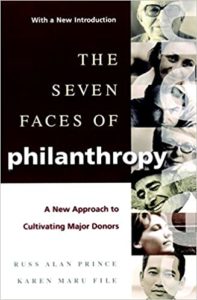The Seven Faces of Philanthropy
What motivates affluent people to make major planned gifts to nonprofit organizations like your church? In The  Seven Faces of Philanthropy: A New Approach to Cultivating Major Donors (Jossey-Bass, 1994), Russ Prince and Karen File lay out the results of a sophisticated sampling of wealthy givers across the United States.
Seven Faces of Philanthropy: A New Approach to Cultivating Major Donors (Jossey-Bass, 1994), Russ Prince and Karen File lay out the results of a sophisticated sampling of wealthy givers across the United States.
What did they learn? Plenty! They discovered seven types of philanthropists: people whose primary motivations for giving will sound familiar to many of us in the church. Their main motives are listed here in order of percent of major givers in the U.S.:
- Communitarian (26%) – Doing good makes sense
- Devout (21%) – Doing good is God’s will
- Investor (15%) – Doing good is good for business
- Socialite (11%) – Doing good is fun
- Repayer (10%) – Doing good in return
- Altruist (9%) – Doing good feels right
- Dynast (8%) – Doing good is a family tradition.
But the categories are just a start. In Part 1, Seven Faces goes into detail about each type of giver, including sociological data on business and social background, perspectives, and expectations about giving. The authors also describe why people in each group give, how they choose their causes, and which types of organizations they most often support.
So far so good. But what are the most fruitful ways to cultivate their giving? This is the focus of Part 2, where Prince and File describe these four steps in order to encourage major giving:
- Find and attract donors by connecting through “charity networks;”
- Craft the vision of your church’s mission and ministry in the donors’ minds, using positive (language) images that are most vibrant for each giving group;
- Raise their awareness, knowledge and interest in different ways to make a major planned gift; and
- Encourage their personal involvement and relationship with your ministry.
While all major donors go through the same cultivation process, the authors show how each of the seven “faces” responds best to a particular approach at each of the four steps.
Seven Faces is a natural resource for nonprofit institutions with major gift- or development officers. It can also be a gold mine of insights for two kinds of congregations:
The first is a church whose leaders want to explore the primary motivations for all to make committed giving in their churches, and various ways to relate their ministries best.
The second kind is a congregation whose leaders are ready to actively seek planned gifts and lead givers through an individualized approach.
For churches in either of these two situations, The Seven Faces of Philanthropy is a treasure well worth discovering.
Betsy Schwarzentraub


